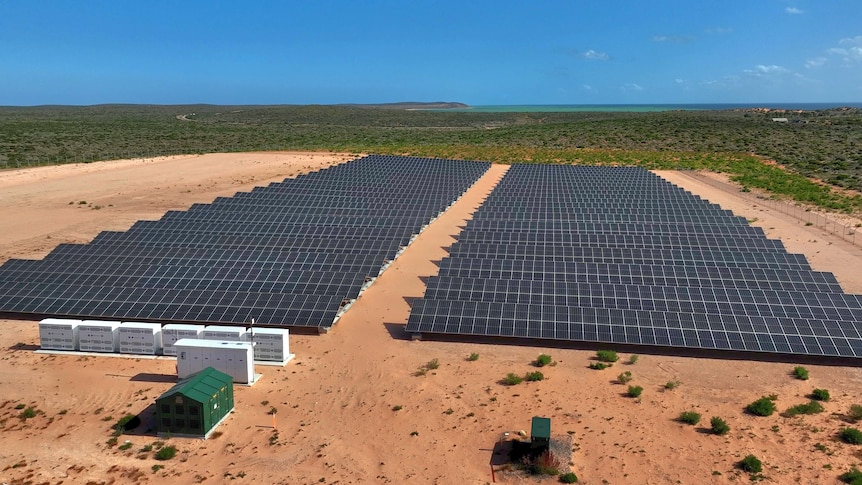Plans by the federal government for Australia to generate more than four-fifths of its power from renewable sources by 2030 are coming under pressure amid claims the country is way off track.
Key points:
-
There are increasing suggestions Australia will fall short of its 2030 renewable power target of 82 per cent
-
Analysts predict Australia’s share of renewable energy is on track to be about 60 per cent at the current rate of progress
-
The forecasts come amid mounting opposition to projects such as transmission lines in some parts of Australia
What are the motivations behind this article? What are the interests of the organisations quoted? Are NIMBYs the only bottleneck? Is it only one place in Victoria that’s affected or are there more? Are there any technical engineering issues involved? What do you think of the suggestion to switch government incentives from rooftop solar to batteries? How quickly could that happen?
What are the motivations behind this article?
The ABC has a mandate to deliver “accurate, impartial, and independent news”. It’s a government agency and failing deliver that would likely result in serious consequences for anyone who decided not to publish this content.
Articles like this one are a critical component of the way democracy works in this country. Keeping people informed of progress on mitigating climate change is absolutely critical.
What are the interests of the organisations quoted?
That gets a bit more tricky. Nexa is a research organisation that does research into whatever someone pays them to research. They’re not unbiased - I don’t think they’ve said who funded them for this paper?
Are NIMBYs the only bottleneck?
Um. No. Obviously not. But they’re a big one.
Is it only one place in Victoria that’s affected or are there more?
Again, obviously, there are more.
Are there any technical engineering issues involved?
… yes?
What do you think of the suggestion to switch government incentives from rooftop solar to batteries?
I think the world doesn’t have the capacity to produce batteries in the quantities required even if nobody every uses one in a home, so, no. If anything batteries at home should be heavily discouraged. We need those batteries for electric vehicles, not houses.
How quickly could that happen?
Nowhere near quickly enough.
For transmission (at least in NSW) there’s a fair bit of bad blood because transgrid has a history of building unnecessary powerlines. They get paid on their asset base and were building a lot of powerlines that had no use in any reasonable projections, only in bullshit projections from transgrid.
That’s now made it very hard for these projects to be done as there’s a history of the bad projects that’s pretty recent.
I’m not saying that these aren’t necessary now, but it’s no surprise people are opposing them with the history transgrid has.
For example they dumped a proposed Stroud to landsdowne powerline around 2012 after it was shown to be just the trying to increase their regulated asset base
This is the best summary I could come up with:
The forecasts that Australia will undershoot the goal come as resistance grows to a number of major high-voltage power lines that backers say are essential to connecting ever greater amounts of wind and solar generation.
Opponents of planned transmission lines in Victoria have stepped up their attacks on the proposals, which they claim would cause needless social and environmental damage while saddling consumers with billions in extra costs.
He noted that a key plank of the federal government’s renewable energy agenda was its so-called rewiring the nation scheme, which had set aside $20 billion in low-cost loans to help kickstart the development of transmission lines.
In a recent report, energy analysts Nexa Advisory found about 60 per cent of the electricity generated in Australia’s biggest grid was likely to be renewable by 2030, based on the current trajectory.
While coal plants could be turned down to accommodate surges in wind and solar power at windy and sunny times, he said they typically had to run at between 30 and 50 per cent of their maximum output for technical reasons.
Eraring is scheduled for closure in August 2025, but NSW Energy Minister Penny Sharpe is coming under increasing pressure to keep at least some of the plant online in a move that would reportedly cost taxpayers hundreds of millions of dollars a year.
I’m a bot and I’m open source!
NIMBYism was really useful for stopping bad projects, but it doesn’t stop just because suddenly they’re good projects. Industrial scale power production and distribution is ugly.
Unfortunately industrial scale renewable energy is probably many times more efficient than whatever alternative there is.
People just gotta accept some wind turbines and solar farms.
I’ll accept them, I think they look fucking sick as.
Not everyone appreciates a solarpunk aesthetic, but I certainly do as well.
It depends.
Up in Canada where I live, we tried that experiment with respect to solar, and it is a failed experiment. You can build a one gigawatt solar farm, and for the most part it’s going to be getting a trivial percentage of nameplate capacity basically all the time. Check the ieso and you’ll see that fact manifest. Wind does ok, hydroelectric works great, solar doesn’t make any sense in places without much sun.


